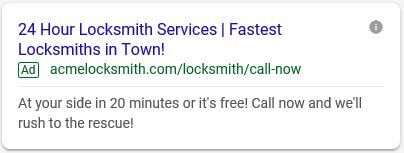Improving Your Call to Action: A Mind Reader’s Guide
by Jacob Baadsgaard • February 22, 2019
Buy now! Learn more! Sign up! Shop now!
These days, we’re surrounded by so many online advertisements with these basic one-liner calls-to-action that it can be easy to start assuming they’re the only way to end an ad.
It’s not that these old stand-by phrases are bad, per se—they can certainly be effective in the right circumstances—but if even marketers are taking them for granted then customers are almost certain to do the same.
An ad’s call to action (CTA) deserves just as much attention as any other part of the presentation—perhaps more. After all, your CTA is where you get a chance to tell viewers what you want them to do after seeing your ad…and if they don’t get that right then nothing else matters.
Luckily, there are some simple ways to spice up your calls to action to make them more engaging.
All you have to do is become a mind-reader…

I’m kidding, of course…but only sort of. If you can get inside your audience’s heads then you have all the tools you need to write calls to action that will really inspire them.
This post will give examples of three ways to read your audience’s minds and give them a custom tailored CTA. I’ll be focusing on pay-per-click (PPC) search engine text ads, but the principles apply equally to any type of advertisement.
Give People What they Want
One of the easiest ways to get ad clicks is if the call to action asks audience members to do something they already want to do!
But, short of being an actual psychic, how in the world could you know what an internet surfer hundreds of miles away wants? The answer is simple—they tell you through the keywords they search with.
Example 1: Everyone has their price…
If somebody types “free online exercise classes” into their search bar, what can we guess about them?
Well, they want to stream exercise instruction into their home…that much is clear…but just as importantly, they want it for free.
This consumer’s commitment level is pretty low, so calls to action like “Sign me up!” and “Subscribe now!” may scare them off. If you’re trying to win clicks from this potential customer, your job will be to demonstrate that you can provide the best quality product in the safest, lowest stress environment possible.
In this ad, the word “free” appears both in the ad headline and in the call to action and the rest of the ad implies that you can get high-quality content with minimal commitment.
Now, the value of customers looking for free stuff is debatable, but if you want their clicks, it helps to make it clear that you’ve got what they want.
Example 2: Compare and Contrast
This time, let’s say your potential customer searches for “best tile saws for granite”. This search includes a product keyword (“tile saw”), showing that they probably want to buy a tool you sell. However, it also indicates that they have a specific project in mind and want the best saw for cutting granite.
“Best” is a comparison word, so what this consumer wants is to compare options.
An ad like this, with a call to action inviting them to read reviews, may be just what the doctor ordered:
This ad invites the reader to do the comparing that they want to do. It may not say “buy now” but if the customer finds their ideal saw on your website, then that’s where they’re likely to buy it.
Example 3: Time is of the Essence
In contrast to the previous queries, a search like “locksmith near me” implies a sense of urgency. In many cases, people don’t search for locksmiths unless they’re locked out of a car or house. Adding “near me” to the search only emphasizes the urgency of the situation.
This person wants help, and they want it NOW!
An ad like this promises to deliver what they’re after:
You’ll notice that this ad is in mobile format. People making this search probably aren’t sitting comfortably behind a desktop computer, so an ad like this should be optimized for mobile.
In fact, a call-only campaign with a click-to-call button could be a great potential call-to-action here. Someone standing in the cold, locked out of their car in the cold is more likely to choose an ad that allows them to call with one click than to go rooting through a website for contact information.
Get Personal
If you can read your audience’s minds you have the chance to really get personal with your ads.
No…I don’t mean crossing any personal boundaries.

What I mean is that you can add a human touch to your ads and your calls-to-action to prove that you know your viewers are real people…and that you’re real people too.
Example 1: Shared Interests
A search like “cat adoption in metropolis” indicates that the user isn’t just interested in general information about cat adoption—they are actually interested in adopting, and are looking for options in their home town.
Adopting a pet usually involves forming a loving bond with it. A call to action like “browse our huge inventory” would feel cold and off-putting.
On the other hand, a call to action like “Meet our furry friends today” on the other hand, implies that you love your animals and hope others will share your affection—just what a potential adopter wants to hear.
Showing that you feel the same way about what you’re advertising as your audience does builds trust and helps people feel safe in clicking your ads.
Example 2: Casual Lingo
Buying an engagement ring is another occasion marked by a lot of emotion. When the internet surfer goes the distance and searches for “custom engagement rings”, you can be extra sure that they really want the personal touch.
This ad opens with an informal misspelled word to emphasize that the jewelers are human, approachable, and relatable. Once the audience is convinced of this, it will be much easier for them to heed the call to action to “call now” and talk to these people.
Using casual language can be a nice way to make your ads stand out from the crowd, but use caution with this approach, as it can easily be over-done.
Example 3: Telling a Story
A third way to add the personal touch to your ads is to showcase your customers.
When somebody searches for “best orthodontist in metropolis”, for example, a single picture may be worth a thousand reviews.
An ad that puts a real person front and center and invites you to learn about them can feel more genuine than simple statistics about a company.
This ad may not cut to the chase and ask potential clients to schedule right away, but “read Jane’s story” feels much more clickable than “schedule now” and after viewers see Lois Lane’s smile on your landing page they may be ready to make the next conversion.
This technique can work with any old Jane Doe, but the more familiar the person in your ad is, the better. If you happen to have customers who are celebrities or local pillars, you might consider asking them if you can use their name and story in your marketing.
Add Urgency
The final technique to make your CTAs more effective is to give them a sense of urgency. Offering what your viewers want makes your ads logical to click and adding a personal touch makes the click feel less threatening, but why should they click now? Why not in a week or a year?
This is where adding urgency comes in.
Example 1: Time-limited Offers
A search like “glossy printer paper 8 1/2 x 11”, which basically just describes a product, usually comes from a searcher with a high intent to buy.
But why should they choose your product, and why should they choose it now?
The simplest reason you can give them is a time-limited promotion:
For a search with high purchase intent, standard calls-to-action like “buy now” can be perfectly appropriate, but offering an extra 20% off as an incentive can help seal the deal today.
Example 2: Fear of Missing Out
A time-limited offer makes your audience feel that if they hesitate they will lose out on an opportunity to save. This motivation is commonly called “fear of missing out”, or FOMO for short.
Short-term discounts aren’t the only way to create a FOMO, though.
For example, if someone searches for “online dating”, they’re probably considering online dating, but they aren’t completely sold on one platform yet. A person like this might beat around the bush for months before finally committing to a subscription.
A little FOMO might be just what they need to light a fire under their seat.
In this case, the reader’s fear is not of losing out on a deal, but rather of missing out on the love of their life. A line like “be the first to meet” implies that new singles using the service are unattached…but won’t be for long!
Example 3: Negative Terms
Finally, a search like “stretches for back pain” implies that the someone isn’t necessarily looking for a product or service. They’re probably just hoping to find some education online.
The search does, however, tell you their “pain point”…in the most literal way possible!
When you know what’s bugging your audience, then you can drum up a sense of urgency for relief:
Being overly negative in your advertising can backfire, but an approach like this uses something negative (a potential patient’s existing pain) to motivate them to act now! In this scenario, the advertiser becomes the hero of the story, saving a potential client from pain.
Making the Most of Your Call to Action
With the right call to action mind-reading can almost turn into mind-control.
But it’s not as mean as it sounds. Your psychic journey should begin with really getting to know your audience well. Interview them. Read about them. Do whatever it takes to really understand their desires, motivations, habits and preferences.
The next step is to put that knowledge to use by going through the keywords you’re bidding on, doing a little mind-reading to determine what people are thinking when they type those words (the same exercise we did nine times in this article) and creating an ad copy and a call to action to match.
This will mean making a lot of ad copy, but—like the terracotta warriors—each will be a unique (and effective) work of art.

To really capitalize on your great text ad CTAs though, you need to get equally granular in your landing pages. If your ad invites people to read Jane Doe’s story, you’d better be linking to a landing page that delivers on that expectation. Betray your customers’ expectations and they’re likely to bounce right off your page.
Finally, as much as you might learn about your customers, your mind-reading will never be perfect. You should continually refine your approach by A/B testing of your ads and landing pages. The more you test the more you’ll learn, and the better you can meet your customers’ needs.
Conclusion
I’ve mentioned a few of the basic techniques you might test to improve your call to action performance, but there are lots more out there.
As mentioned above, the trick is to evaluate your keywords and try to understand the intent behind the searches that will trigger those keywords. Then, once you know why people are triggering your ads, you can use that to create a call to action that’s irresistible.
By the way, if you’d like some help coming up with an effective call to action for your ads, let me know here or in the comments. I’d love to help!
I’d love to hear some of the most effective call to action tactics you’ve discovered and what they’ve taught you about your audiences. Leave your thoughts in the comments!














